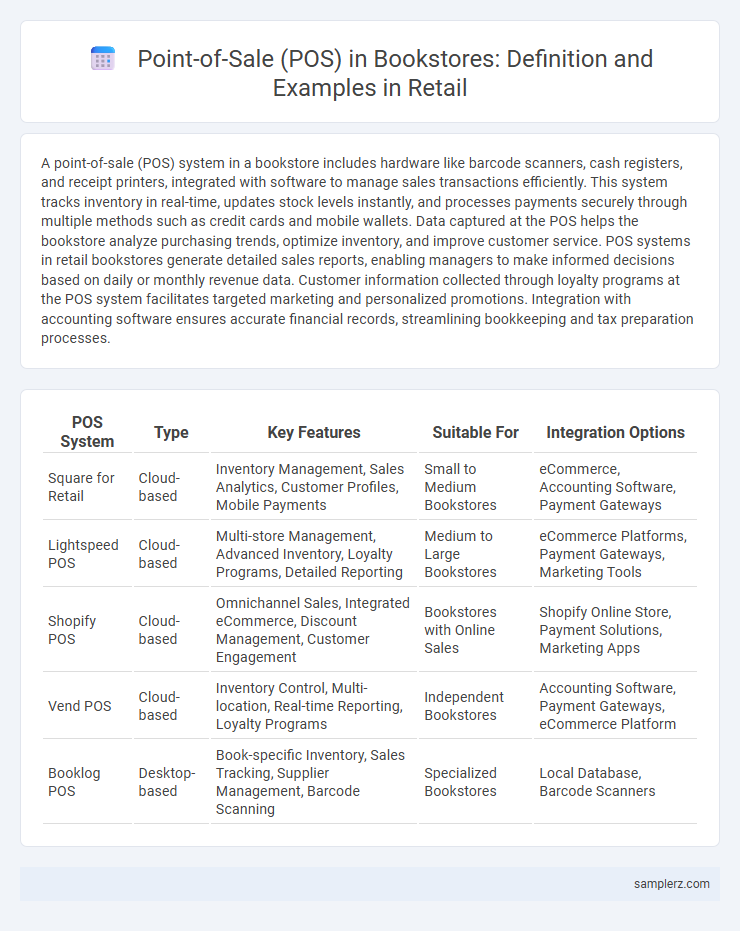A point-of-sale (POS) system in a bookstore includes hardware like barcode scanners, cash registers, and receipt printers, integrated with software to manage sales transactions efficiently. This system tracks inventory in real-time, updates stock levels instantly, and processes payments securely through multiple methods such as credit cards and mobile wallets. Data captured at the POS helps the bookstore analyze purchasing trends, optimize inventory, and improve customer service. POS systems in retail bookstores generate detailed sales reports, enabling managers to make informed decisions based on daily or monthly revenue data. Customer information collected through loyalty programs at the POS system facilitates targeted marketing and personalized promotions. Integration with accounting software ensures accurate financial records, streamlining bookkeeping and tax preparation processes.
Table of Comparison
| POS System | Type | Key Features | Suitable For | Integration Options |
|---|---|---|---|---|
| Square for Retail | Cloud-based | Inventory Management, Sales Analytics, Customer Profiles, Mobile Payments | Small to Medium Bookstores | eCommerce, Accounting Software, Payment Gateways |
| Lightspeed POS | Cloud-based | Multi-store Management, Advanced Inventory, Loyalty Programs, Detailed Reporting | Medium to Large Bookstores | eCommerce Platforms, Payment Gateways, Marketing Tools |
| Shopify POS | Cloud-based | Omnichannel Sales, Integrated eCommerce, Discount Management, Customer Engagement | Bookstores with Online Sales | Shopify Online Store, Payment Solutions, Marketing Apps |
| Vend POS | Cloud-based | Inventory Control, Multi-location, Real-time Reporting, Loyalty Programs | Independent Bookstores | Accounting Software, Payment Gateways, eCommerce Platform |
| Booklog POS | Desktop-based | Book-specific Inventory, Sales Tracking, Supplier Management, Barcode Scanning | Specialized Bookstores | Local Database, Barcode Scanners |
Key Features of Point-of-Sale Systems in Bookstores
Point-of-sale systems in bookstores offer inventory management specifically tailored to track book titles, authors, and genres, enabling precise stock control and reorder automation. These systems incorporate customer data collection and loyalty program integration to personalize promotions and enhance customer retention. Additionally, seamless integration with e-commerce platforms allows bookstores to unify sales channels and optimize order fulfillment.
Benefits of POS Solutions for Book Retailers
POS solutions in bookstores streamline inventory management by accurately tracking sales of diverse book titles, enabling timely restocking and minimizing stockouts. These systems enhance customer experience through fast, efficient checkouts and integrated loyalty programs tailored specifically for book buyers. Data analytics from POS platforms help book retailers identify bestsellers and seasonal trends, optimizing marketing strategies and increasing overall revenue.
Real-Life Examples of POS Operations in Bookstores
A bookstore's point-of-sale (POS) system streamlines transactions by integrating barcode scanning with inventory management, allowing staff to quickly process purchases and track stock levels in real-time. Many bookstores use POS software like Square or Lightspeed, which supports customer data collection for personalized marketing and loyalty programs. During seasonal promotions, the POS system automatically applies discounts and generates sales reports, enhancing operational efficiency and customer experience.
Integrating Inventory Management with POS in Bookstores
Integrating inventory management with POS systems in bookstores streamlines stock tracking and reduces out-of-stock instances by automatically updating inventory levels with each sale. Real-time data synchronization enables accurate demand forecasting, facilitating efficient restocking and minimizing holding costs. This integration enhances customer satisfaction by ensuring popular titles are readily available and supports data-driven decision-making to optimize book assortment.
Enhancing Customer Experience with Bookstore POS
Bookstore point-of-sale (POS) systems integrate inventory management, personalized recommendations, and seamless checkout processes to enhance customer experience. Features like real-time stock updates and customer purchase histories enable tailored promotions and efficient service. Contactless payments and digital receipts minimize wait times, fostering convenience and satisfaction during each visit.
Popular POS Software Options for Bookstores
Popular POS software options for bookstores include Square for Retail, which offers inventory management tailored to books and integrated payment processing. Lightspeed POS provides specialized features like customer profiles and sales analytics designed for bookstores to optimize inventory turnover and promotions. Another leading solution is Vend by Lightspeed, known for its user-friendly interface and seamless integration with e-commerce platforms, enhancing the in-store and online sales experience.
Streamlining Checkout Processes in Book Retail Outlets
Point-of-sale systems in bookstores integrate barcode scanning and inventory management to streamline checkout processes, reducing customer wait times and minimizing errors. Advanced POS terminals support multiple payment options, including contactless cards and mobile wallets, enhancing transaction speed and convenience. Real-time sales tracking enables staff to manage stock levels efficiently, ensuring a seamless retail experience.
Case Study: POS Implementation in Independent Bookstores
Independent bookstores often implement cloud-based POS systems tailored for inventory management, sales tracking, and customer engagement. Case studies reveal that integrating mobile payment options and real-time stock updates enhances checkout efficiency and customer satisfaction. Data from these implementations show a 20% increase in transaction speed and a 15% boost in repeat customer visits.
Challenges Facing Bookstores Adopting POS Systems
Bookstores face significant challenges when adopting point-of-sale (POS) systems, including inventory management complexities due to diverse product categories such as new releases, textbooks, and rare books. Integration difficulties arise as retailers strive to synchronize POS software with existing accounting and e-commerce platforms. High initial setup costs and ongoing maintenance expenses further complicate the transition for small independent bookstores.
Future Trends in Bookstore Point-of-Sale Technology
Future trends in bookstore point-of-sale technology emphasize AI-driven analytics to personalize customer recommendations, enhancing purchase experiences. Integration of augmented reality allows buyers to preview books and related content digitally before purchase, boosting engagement. Contactless payment systems combined with mobile POS devices streamline transactions and improve operational efficiency in retail environments.

example of point-of-sale in bookstore Infographic
 samplerz.com
samplerz.com